Are you planning a road trip between Taos and Santa Fe, New Mexico, and wondering about the distance and what to see along the way? Gaymexico.net provides the answers, offering a curated guide for LGBTQ+ travelers looking to explore the Land of Enchantment. Discover scenic routes, historic sites, and cultural gems in New Mexico. If you’re curious about Southwestern road trip itineraries, historic New Mexico travel, or LGBTQ+ friendly destinations, keep reading!
1. What is the Distance Between Taos and Santa Fe, New Mexico?
The distance between Taos and Santa Fe, New Mexico, depends on the route you choose, but it’s approximately 65 to 70 miles (105 to 113 kilometers) via the most direct route. However, many travelers opt for the scenic “High Road to Taos,” which, while longer, offers a richer cultural and visual experience. According to the New Mexico Tourism Department, the High Road spans about 105 miles (170 kilometers) and can take anywhere from 2.5 to 7 hours to drive, depending on how many stops you make.
The High Road is more than just a drive; it’s an immersive journey through centuries of history and tradition. It winds through the Sangre de Cristo Mountains, passing through small villages that have preserved their Spanish colonial heritage. This route offers stunning vistas and numerous opportunities to explore historic churches, artisan studios, and local cuisine.
Choosing Your Route: Direct vs. Scenic
When traveling between Taos and Santa Fe, you have two primary options:
- The Direct Route (Highway 68): This is the fastest way to travel between the two cities, typically taking about 1.5 to 2 hours without stops. It’s a straightforward drive along the Rio Grande River valley, offering pleasant views but fewer opportunities for exploration.
- The High Road to Taos (Highways 503, 76, and 518): This scenic route meanders through the mountains, offering a glimpse into the heart of northern New Mexico. While it takes longer, the High Road is packed with cultural and historical attractions.
Factors Affecting Travel Time
Several factors can influence your travel time between Taos and Santa Fe:
- Traffic: While traffic is generally light in this part of New Mexico, it can increase during peak tourist seasons (summer and holidays) and around major events.
- Weather: Winter weather can significantly impact travel times, especially on the High Road. Snow and ice can make some sections treacherous, so it’s essential to check the forecast and road conditions before you go.
- Stops: The more stops you make, the longer your trip will take. If you plan to explore the villages and attractions along the High Road, allocate at least 4 to 7 hours for the journey.
2. What is the High Road to Taos, and Why Should I Take It?
The High Road to Taos is a scenic byway that offers a unique glimpse into the cultural heart of New Mexico, providing a rich, immersive experience for travelers, especially those interested in art, history, and local traditions. According to the National Scenic Byways Program, it showcases the region’s unique blend of Native American, Spanish, and Anglo cultures. This winding route is not just a means of getting from Santa Fe to Taos; it’s a destination in itself, filled with historic sites, art galleries, and breathtaking landscapes.
Cultural Significance of the High Road
The High Road is steeped in history, passing through villages that have maintained their cultural identity for centuries. These communities are known for their traditional arts and crafts, including weaving, wood carving, and pottery.
- Spanish Colonial Heritage: Many of the villages along the High Road were founded in the 17th and 18th centuries, and their architecture reflects this Spanish colonial heritage. Adobe churches, plazas, and homes are common sights, offering a tangible connection to the past.
- Artistic Traditions: The region has long been a haven for artists, drawn to its unique light and cultural richness. You’ll find numerous galleries and studios along the High Road, showcasing the work of local painters, sculptors, and artisans.
- Religious Significance: The High Road is home to several historic churches, some of which are considered sacred sites. The Santuario de Chimayó, known for its healing earth, is a major pilgrimage destination.
Key Stops Along the High Road
The High Road to Taos offers a variety of attractions, each providing a unique glimpse into the region’s history and culture. Some notable stops include:
- Chimayó: Famous for the Santuario de Chimayó, a historic church believed to have healing powers. The village is also known for its traditional weaving.
- Cordova: A village known for its woodcarvers, offering a chance to see and purchase unique handcrafted items.
- Truchas: Built on a mesa with stunning views of the Truchas Peaks, this village is home to the Nuestra Señora del Rosario church, which features well-preserved old santos.
- Las Trampas: Home to the San Jose de Gracia church, a National Historic Landmark that has been in continuous use for over 200 years.
- Ranchos de Taos: Features the iconic San Francisco de Asis Church, a massive adobe structure that has been depicted in the works of Georgia O’Keeffe and Ansel Adams.
 A view down the highway on the High Road, partly cloudy skies and green trees covering the high desert
A view down the highway on the High Road, partly cloudy skies and green trees covering the high desert
Tips for Planning Your High Road Trip
To make the most of your journey along the High Road to Taos, consider these tips:
- Start Early: The High Road can take a full day to explore, so start early to allow plenty of time for stops.
- Check the Weather: Especially during the winter months, check the weather forecast and road conditions before you go.
- Bring Cash: Many of the small villages along the High Road have limited ATM access, so it’s a good idea to bring cash for purchases.
- Respect Local Customs: The villages along the High Road are proud of their cultural heritage, so be respectful of local customs and traditions.
- Visit gaymexico.net: For more detailed travel tips, LGBTQ+ friendly recommendations, and insider information, visit gaymexico.net to enhance your experience.
3. What are the Must-See Attractions on the High Road?
The High Road to Taos is dotted with cultural and historical treasures, each offering a unique perspective on Northern New Mexico’s rich heritage. From ancient churches to thriving art communities, here are some must-see attractions along the route.
San Francisco de Asis Church in Ranchos de Taos
This iconic adobe church is one of the most photographed and painted landmarks in New Mexico. According to the church’s historical records, it was completed in the early 19th century and has been a central part of the Ranchos de Taos community ever since. Its massive adobe buttresses and unique architecture have attracted artists like Georgia O’Keeffe and Ansel Adams.
- Architectural Significance: The church’s design reflects traditional Spanish colonial architecture, with thick adobe walls, high ceilings, and hand-carved corbels.
- Artistic Legacy: Georgia O’Keeffe and Ansel Adams both created famous works of art depicting the church, solidifying its place in American art history.
- Community Hub: The church remains an active center of community life, hosting regular services and cultural events.
Santuario de Chimayó
Known as the “Lourdes of America,” the Santuario de Chimayó is a historic church and pilgrimage site believed to have healing powers. Every year, thousands of people visit the Santuario to collect “holy dirt” from a small pit inside the church, which they believe can cure illnesses.
- Historical Significance: The Santuario dates back to the early 19th century and is built on land believed to have sacred properties.
- Pilgrimage Site: The church attracts pilgrims from all over the world, particularly during Holy Week.
- Healing Traditions: The “holy dirt” from the Santuario is believed to have miraculous healing powers, drawing visitors seeking physical and spiritual renewal.
San Jose de Gracia Church in Las Trampas
This well-preserved Spanish colonial church is a National Historic Landmark and a testament to the enduring cultural traditions of Northern New Mexico. According to the National Park Service, the church was completed in 1776 and has been in continuous use ever since.
- Architectural Style: The church is built in the cruciform style, with two towers and traditional adobe construction.
- Historical Importance: San Jose de Gracia is one of the best-preserved examples of Spanish colonial architecture in the United States.
- Community Legacy: The church continues to serve as a vital center of community life in Las Trampas.
Truchas
This picturesque village is perched on a mesa, offering stunning views of the surrounding landscape. Truchas is known for its artistic community and the Nuestra Señora del Rosario church, which houses a collection of well-preserved old santos (religious images).
- Scenic Views: The village’s location on a mesa provides panoramic views of the Truchas Peaks and the Sangre de Cristo Mountains.
- Artistic Hub: Truchas is home to numerous artists and galleries, showcasing a variety of traditional and contemporary works.
- Religious Heritage: The Nuestra Señora del Rosario church is a beautiful example of Spanish colonial religious art and architecture.
Cordova
Known as a village of woodcarvers, Cordova offers a unique opportunity to see and purchase handcrafted items from local artisans. The San Antonio de Padua Church is a focal point of the village, showcasing traditional religious art.
- Woodcarving Tradition: Cordova has a long history of woodcarving, with many families passing down the craft for generations.
- Artisan Community: The village is home to numerous workshops and galleries where you can see woodcarvers at work and purchase their creations.
- Religious Art: The San Antonio de Padua Church features a large altar screen painted by Rafael Aragon, a renowned New Mexican artist.
 Adobe San Jose de Garcia Church
Adobe San Jose de Garcia Church
Additional Attractions
- Ojo Sarco: A small village known for its artists’ studios, offering a chance to meet local artists and purchase their work.
- Peñasco: A farming community surrounded by the Carson National Forest, offering opportunities for hiking and outdoor recreation.
- Talpa: Home to the charming little church of Nuestra Señora de San Juan de los Largos del Rio Chiquito.
- Fort Burgwin: A historic fort owned by Southern Methodist University, used for university classes and research.
Planning Your Itinerary
To make the most of your trip along the High Road, it’s helpful to plan your itinerary in advance. Consider which attractions are most important to you and allocate enough time to explore them thoroughly. Remember to check the opening hours of churches and museums, as they may vary depending on the season. Also, allow time for spontaneous stops and detours – you never know what hidden gems you might discover along the way.
Gaymexico.net offers detailed guides and recommendations for planning your trip along the High Road, including LGBTQ+ friendly accommodations and activities.
4. What are the Best LGBTQ+ Friendly Stops Between Taos and Santa Fe?
While the High Road to Taos is known for its cultural and historical attractions, LGBTQ+ travelers can find welcoming and inclusive spaces to enjoy along the way. Although smaller towns may not have dedicated LGBTQ+ venues, the general atmosphere of openness and acceptance in Northern New Mexico makes for a pleasant experience. Gaymexico.net highlights some of the best stops that are known for their inclusivity and appeal to a diverse range of visitors.
Santa Fe: A Welcoming Start
Santa Fe, with its vibrant arts scene and progressive culture, is an excellent starting point for your journey. The city has a well-established LGBTQ+ community and offers a variety of welcoming establishments.
- Accommodation: Several hotels and guesthouses in Santa Fe are known for their LGBTQ+ friendliness. Check online reviews and ratings to find accommodations that suit your preferences.
- Dining: Santa Fe’s culinary scene is diverse and inclusive, with many restaurants and cafes welcoming LGBTQ+ patrons. Look for establishments that display rainbow flags or have positive reviews from LGBTQ+ travelers.
- Arts and Culture: Santa Fe’s arts scene is a major draw for visitors, and many galleries and museums showcase works by LGBTQ+ artists. The Georgia O’Keeffe Museum and the Museum of International Folk Art are popular choices.
Taos: A Relaxed and Inclusive Destination
Taos, like Santa Fe, is known for its relaxed atmosphere and artistic community, making it a welcoming destination for LGBTQ+ travelers.
- Accommodation: Taos offers a range of accommodations, from cozy bed and breakfasts to luxurious resorts. Look for LGBTQ+ friendly options when booking your stay.
- Dining: Taos’s dining scene is diverse, with many restaurants offering delicious New Mexican cuisine and international flavors. Check out local cafes and eateries for a taste of the town’s culinary offerings.
- Outdoor Activities: Taos is a haven for outdoor enthusiasts, with opportunities for hiking, skiing, and exploring the surrounding mountains. The area’s natural beauty is a major draw for visitors.
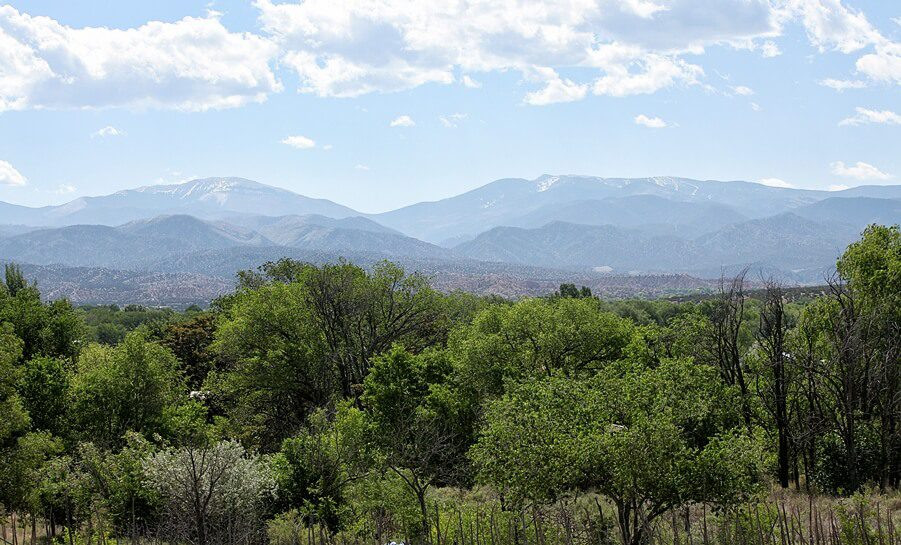 A view of mountains in the distance off the High Road
A view of mountains in the distance off the High Road
Villages Along the High Road
While the smaller villages along the High Road may not have dedicated LGBTQ+ venues, their welcoming atmosphere and cultural attractions make them worth exploring. Here are some tips for enjoying these destinations:
- Chimayó: Visit the Santuario de Chimayó and explore the village’s weaving shops. The local community is generally welcoming to all visitors.
- Cordova: Explore the village’s woodcarving studios and meet local artisans. The area is known for its traditional arts and crafts.
- Truchas: Enjoy the stunning views and visit the Nuestra Señora del Rosario church. The village is a popular destination for artists and photographers.
- Las Trampas: Admire the San Jose de Gracia church and learn about the village’s history. The area is known for its well-preserved Spanish colonial architecture.
Tips for LGBTQ+ Travelers
- Research Accommodations: Before booking your stay, research accommodations to ensure they are LGBTQ+ friendly. Check online reviews and ratings to find establishments that are known for their inclusivity.
- Support Local Businesses: Look for LGBTQ+ owned or friendly businesses to support during your travels. Your patronage can help promote inclusivity and diversity in the community.
- Be Open and Respectful: While Northern New Mexico is generally welcoming, it’s important to be open and respectful of local customs and traditions. Engage with the community and learn about the area’s unique culture.
- Check gaymexico.net: For the latest LGBTQ+ travel tips, recommendations, and insider information, visit gaymexico.net to enhance your experience.
5. What Outdoor Activities Can I Enjoy Between Taos and Santa Fe?
The area between Taos and Santa Fe offers a wealth of outdoor activities, from hiking and skiing to exploring scenic drives and natural wonders. Whether you’re an adventure seeker or prefer a more relaxed pace, there’s something for everyone to enjoy in this diverse landscape.
Hiking and Backpacking
The Sangre de Cristo Mountains, which run between Taos and Santa Fe, offer numerous hiking trails for all skill levels. According to the U.S. Forest Service, the Carson National Forest and the Santa Fe National Forest are popular destinations for hiking and backpacking.
- Williams Lake Trail: Located near Taos Ski Valley, this moderate 4-mile hike leads to a beautiful alpine lake.
- Pecos Baldy Lake Trail: Located in the Pecos Wilderness, this challenging 10-mile hike offers stunning views of the surrounding mountains.
- Atalaya Mountain Trail: Located near Santa Fe, this moderate 7-mile hike offers panoramic views of the city and the surrounding landscape.
Skiing and Snowboarding
During the winter months, the area between Taos and Santa Fe transforms into a winter wonderland, offering world-class skiing and snowboarding opportunities.
- Taos Ski Valley: Known for its challenging terrain and deep powder, Taos Ski Valley is a popular destination for advanced skiers and snowboarders.
- Ski Santa Fe: Located just a short drive from Santa Fe, Ski Santa Fe offers a variety of runs for all skill levels.
- Angel Fire Resort: Located near Taos, Angel Fire Resort offers a family-friendly skiing experience with a variety of activities for all ages.
Scenic Drives
The area between Taos and Santa Fe is home to some of the most scenic drives in the United States. The High Road to Taos is a must-do for its cultural and historical attractions, but there are other scenic routes to explore as well.
- The Enchanted Circle Scenic Byway: This 84-mile loop around Wheeler Peak, the highest point in New Mexico, offers stunning views of the surrounding mountains and valleys.
- The Turquoise Trail National Scenic Byway: This historic route between Santa Fe and Albuquerque passes through several charming small towns and offers a glimpse into New Mexico’s mining history.
- The River Road: This scenic route follows the Rio Grande River between Taos and Española, offering beautiful views of the river valley.
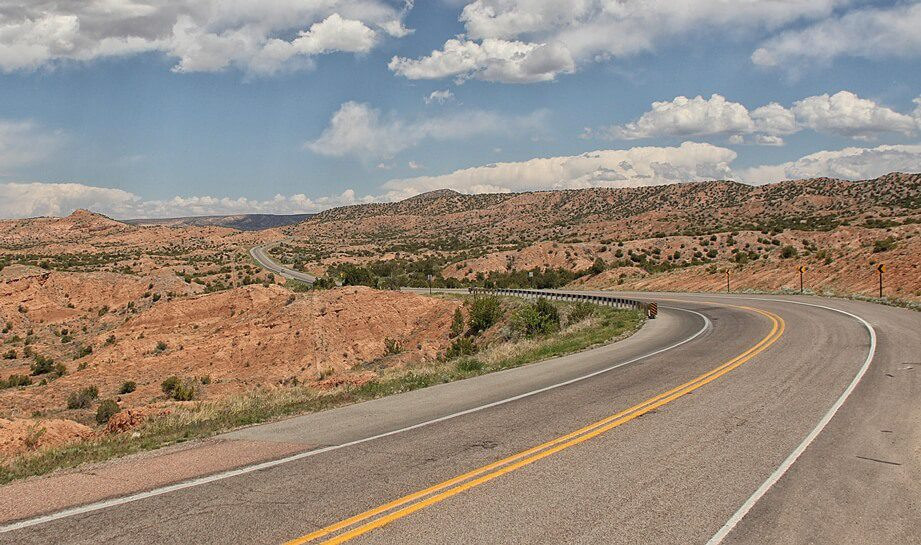 A winding desert stretch of the high road
A winding desert stretch of the high road
Natural Wonders
The area between Taos and Santa Fe is home to several natural wonders, including hot springs, canyons, and geological formations.
- Ojo Caliente Mineral Springs Resort & Spa: Located north of Santa Fe, Ojo Caliente offers a variety of mineral springs for relaxation and rejuvenation.
- The Rio Grande Gorge Bridge: Located near Taos, this impressive bridge spans the Rio Grande Gorge and offers stunning views of the surrounding landscape.
- Bandelier National Monument: Located near Los Alamos, this national monument preserves the ruins of ancient Pueblo villages and offers opportunities for hiking and exploring.
Tips for Outdoor Activities
- Check the Weather: Before embarking on any outdoor activity, check the weather forecast and be prepared for changing conditions.
- Bring Water and Snacks: Stay hydrated and energized by bringing plenty of water and snacks.
- Wear Appropriate Clothing: Dress in layers and wear appropriate footwear for the activity you’re planning.
- Protect Yourself from the Sun: Wear sunscreen, sunglasses, and a hat to protect yourself from the sun’s rays.
- Be Aware of Altitude: The area between Taos and Santa Fe is at a high altitude, so take it easy and allow yourself time to acclimatize.
LGBTQ+ Friendly Outdoor Adventures
While specific LGBTQ+ outdoor groups may not be prevalent in the immediate area, the general acceptance and welcoming atmosphere of Northern New Mexico make it easy for LGBTQ+ travelers to enjoy outdoor activities. Consider joining local hiking groups or outdoor clubs to meet like-minded people and explore the region’s natural beauty.
6. What are the Best Times to Visit Taos and Santa Fe?
The best time to visit Taos and Santa Fe depends on your interests and what you want to experience. Each season offers unique attractions and activities, from skiing in the winter to art festivals in the summer.
Spring (March – May)
Spring is a beautiful time to visit Taos and Santa Fe, as the weather warms up and the landscapes come alive with wildflowers. According to the New Mexico Tourism Department, spring is a great time for hiking and exploring the outdoors.
- Weather: The weather in spring is mild, with average temperatures ranging from the 50s to the 70s.
- Activities: Spring is a great time for hiking, biking, and exploring the scenic drives around Taos and Santa Fe.
- Events: The Santa Fe Film Festival and the Taos Lilac Festival are popular events in the spring.
Summer (June – August)
Summer is the peak tourist season in Taos and Santa Fe, as the weather is warm and sunny, and there are numerous outdoor activities and events to enjoy.
- Weather: The weather in summer is warm and sunny, with average temperatures ranging from the 70s to the 90s.
- Activities: Summer is a great time for hiking, rafting, and attending outdoor concerts and festivals.
- Events: The Santa Fe Opera, the Taos Solar Music Festival, and the Indian Market are popular events in the summer.
Fall (September – November)
Fall is a particularly beautiful time to visit Taos and Santa Fe, as the leaves change color and the landscapes are bathed in golden light. According to local tourism guides, fall is also a great time for cultural events and festivals.
- Weather: The weather in fall is mild, with average temperatures ranging from the 50s to the 70s.
- Activities: Fall is a great time for hiking, scenic drives, and visiting the local wineries and breweries.
- Events: The Santa Fe Wine & Chile Fiesta, the Taos Mountain Film Festival, and the Albuquerque International Balloon Fiesta are popular events in the fall.
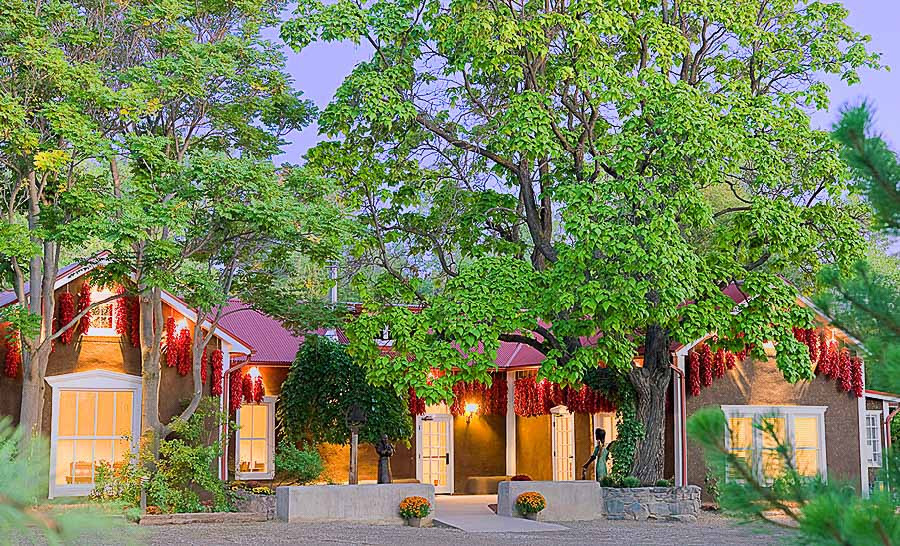 Exterior sunset at Rancho de Chimayo Restaurant
Exterior sunset at Rancho de Chimayo Restaurant
Winter (December – February)
Winter is a magical time to visit Taos and Santa Fe, as the landscapes are covered in snow and there are numerous opportunities for skiing, snowboarding, and other winter activities.
- Weather: The weather in winter is cold, with average temperatures ranging from the 20s to the 40s.
- Activities: Winter is a great time for skiing, snowboarding, and snowshoeing in the nearby mountains.
- Events: The Christmas Eve Farolito Walk in Santa Fe and the Taos Winter Wine Festival are popular events in the winter.
Tips for Choosing the Best Time to Visit
- Consider Your Interests: Think about what activities and events are most important to you and choose the season that best aligns with your interests.
- Check the Weather: Be sure to check the weather forecast before you go and pack accordingly.
- Book in Advance: If you’re planning to visit during the peak tourist season, be sure to book your accommodations and activities in advance.
- Be Prepared for Crowds: The area between Taos and Santa Fe can be crowded during the peak tourist season, so be prepared for longer lines and more traffic.
LGBTQ+ Considerations
All seasons are generally welcoming for LGBTQ+ travelers, but summer and fall often have more events and activities that may appeal to the community. Check local event listings and LGBTQ+ resources for specific events and gatherings.
7. What Dining Experiences Should I Not Miss Between Taos and Santa Fe?
The culinary scene between Taos and Santa Fe is as diverse and vibrant as the landscape itself. From traditional New Mexican cuisine to innovative farm-to-table dining, there’s a culinary adventure waiting around every corner. Here are some dining experiences you shouldn’t miss.
Traditional New Mexican Cuisine
New Mexican cuisine is a unique blend of Spanish, Native American, and Mexican flavors. Be sure to try local specialties like green chile cheeseburgers, red chile enchiladas, and carne adovada.
- Rancho de Chimayó: Located in Chimayó, this historic restaurant is known for its traditional New Mexican cuisine and its beautiful setting.
- The Shed: Located in Santa Fe, The Shed is a local institution known for its red chile dishes and its cozy atmosphere.
- Orlando’s New Mexican Cafe: Located in Taos, Orlando’s offers authentic New Mexican cuisine with a focus on fresh, local ingredients.
Farm-to-Table Dining
The area between Taos and Santa Fe is home to numerous farms and ranches, and many restaurants take advantage of this bounty by offering farm-to-table dining experiences.
- Geronimo: Located in Santa Fe, Geronimo offers a sophisticated farm-to-table dining experience with a focus on seasonal ingredients.
- Lambert’s of Taos: Lambert’s is a fine dining restaurant in Taos that features a menu of contemporary American cuisine with a focus on local and organic ingredients.
- The Love Apple: Housed in a historic church in Taos, The Love Apple offers a unique farm-to-table dining experience with a focus on vegetarian and vegan dishes.
International Flavors
In addition to New Mexican cuisine, the area between Taos and Santa Fe offers a variety of international flavors, from Italian and French to Asian and Mediterranean.
- Sassella: Located in Santa Fe, Sassella offers authentic Italian cuisine in an elegant setting.
- Café des Artistes: Located in Taos, Café des Artistes offers classic French cuisine with a focus on fresh, local ingredients.
- Guadalupe Cafe: Located in Santa Fe, Guadalupe Cafe serves up delicious and creative breakfast and brunch options, with a New Mexican twist.
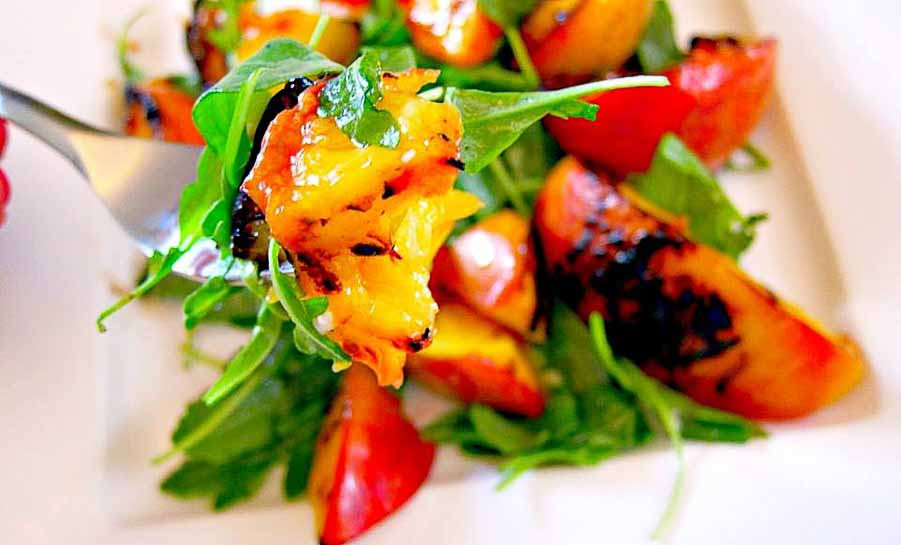 Salads at the sugar nymphs bistro
Salads at the sugar nymphs bistro
Casual Eateries
For a more casual dining experience, check out the area’s many cafes, diners, and food trucks.
- Sugar Nymphs Bistro: Located in Peñasco, Sugar Nymphs Bistro offers delicious sandwiches, salads, and baked goods in a charming setting.
- Taos Diner: Located in Taos, Taos Diner is a classic American diner that serves up hearty breakfasts, burgers, and milkshakes.
- Tune-Up Cafe: Located in Santa Fe, Tune-Up Cafe is a popular spot for breakfast, lunch, and dinner, with a menu of comfort food classics and New Mexican specialties.
Tips for Dining
- Make Reservations: If you’re planning to dine at a popular restaurant, it’s a good idea to make reservations in advance.
- Try Local Specialties: Be sure to try the local New Mexican specialties, like green chile cheeseburgers and red chile enchiladas.
- Check Out Local Markets: Visit local farmers’ markets to sample fresh produce and artisan foods.
- Ask for Recommendations: Ask locals for their favorite dining spots – they’re sure to have some hidden gems to share.
LGBTQ+ Friendly Dining
Most restaurants in Taos and Santa Fe are welcoming to LGBTQ+ patrons. Look for establishments that display rainbow flags or have positive reviews from LGBTQ+ travelers. Gaymexico.net may offer specific recommendations for LGBTQ+ friendly dining in the area.
8. What Cultural Experiences Define the Taos and Santa Fe Region?
The region between Taos and Santa Fe is a cultural melting pot, with influences from Native American, Spanish, and Anglo cultures. This rich heritage is reflected in the area’s art, architecture, music, and traditions. Here are some cultural experiences that define the Taos and Santa Fe region.
Native American Culture
Native American culture is an integral part of the Taos and Santa Fe region. The area is home to several Native American pueblos, each with its own unique history and traditions.
- Taos Pueblo: A UNESCO World Heritage Site, Taos Pueblo is one of the oldest continuously inhabited communities in the United States. Visitors can tour the pueblo and learn about its history and culture. According to UNESCO, the Pueblo has been inhabited for over 1000 years.
- Santa Clara Pueblo: Located near Española, Santa Clara Pueblo is known for its black pottery and its beautiful setting along the Rio Grande River.
- San Ildefonso Pueblo: Located near Los Alamos, San Ildefonso Pueblo is known for its pottery and its role in the development of the atomic bomb.
Spanish Colonial Heritage
The Spanish colonial heritage is evident in the architecture, art, and traditions of the Taos and Santa Fe region.
- Historic Churches: The area is home to numerous historic churches, many of which date back to the Spanish colonial period. These churches are beautiful examples of adobe architecture and feature stunning religious art.
- Traditional Art: Spanish colonial art forms, such as retablos (painted panels) and bultos (carved statues), are still practiced by local artisans.
- Fiestas and Celebrations: The region celebrates numerous fiestas and celebrations throughout the year, many of which have their roots in Spanish colonial traditions.
Art and Architecture
The Taos and Santa Fe region is a mecca for artists and art lovers. The area’s unique light and stunning landscapes have attracted artists for centuries.
- Art Galleries: Taos and Santa Fe are home to numerous art galleries, showcasing a variety of styles and mediums.
- Museums: The area has several world-class museums, including the Georgia O’Keeffe Museum, the Museum of International Folk Art, and the New Mexico Museum of Art.
- Adobe Architecture: The traditional adobe architecture of the region is a defining feature of the landscape. Adobe buildings are made from sun-dried mud bricks and are known for their simple beauty and their ability to blend in with the natural environment.
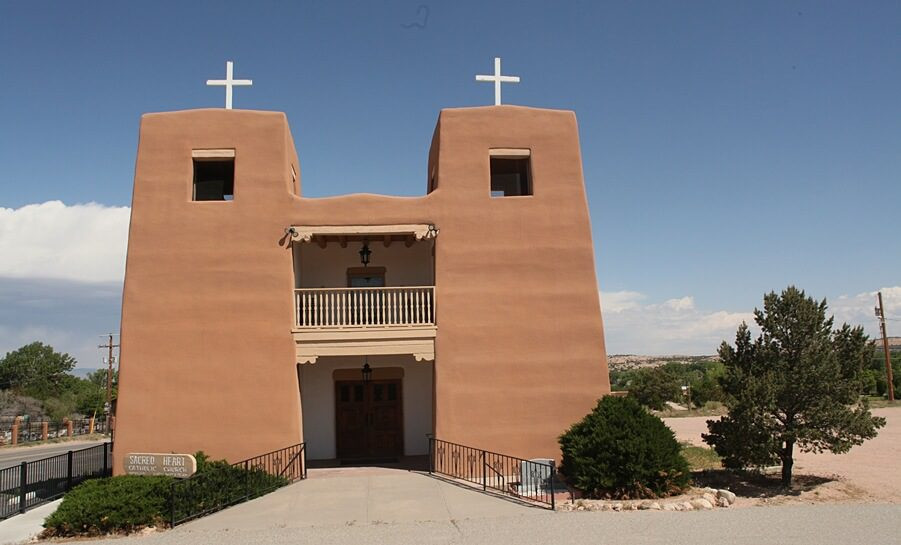 The Adobe Sacred Heart Catholic Church from the front and blue skies
The Adobe Sacred Heart Catholic Church from the front and blue skies
Music and Dance
Music and dance play an important role in the cultural life of the Taos and Santa Fe region.
- Traditional Music: Native American and Spanish colonial music traditions are still alive and well in the region.
- Dance Performances: Several dance groups perform traditional dances throughout the year, showcasing the area’s rich cultural heritage.
- Music Festivals: The region hosts numerous music festivals throughout the year, featuring a variety of genres from classical to country to rock.
Tips for Experiencing the Culture
- Visit Local Museums: Take the time to visit the area’s museums and learn about its rich cultural heritage.
- Attend Local Events: Attend local fiestas, celebrations, and music festivals to experience the culture firsthand.
- Support Local Artisans: Purchase art and crafts from local artisans to support their work and help preserve traditional art forms.
- Be Respectful: Be respectful of Native American and Spanish colonial traditions and customs.
LGBTQ+ Cultural Integration
The Taos and Santa Fe area is generally welcoming to LGBTQ+ individuals and offers opportunities to engage with the local culture in a respectful and inclusive manner. Look for events and organizations that promote diversity and inclusion. Gaymexico.net can provide additional resources and recommendations for LGBTQ+ travelers.
9. How Can I Find LGBTQ+ Friendly Accommodations in Taos and Santa Fe?
Finding comfortable and welcoming accommodations is a priority for many LGBTQ+ travelers. Taos and Santa Fe offer a variety of options, from hotels and guesthouses to vacation rentals and bed and breakfasts, that cater to the LGBTQ+ community. Here’s how to find the best LGBTQ+ friendly accommodations in the area.
Online Resources
Several online resources can help you find LGBTQ+ friendly accommodations in Taos and Santa Fe.
- LGBTQ+ Travel Websites: Websites like gaymexico.net, Expedia, and Travelocity often have sections dedicated to LGBTQ+ travel, with listings of hotels and guesthouses that are known for their inclusivity.
- Online Reviews: Check online reviews and ratings from other LGBTQ+ travelers to get an idea of the experiences they had at different accommodations.
- Hotel Websites: Visit the websites of individual hotels and guesthouses to learn more about their policies and amenities. Look for statements of inclusivity or mentions of LGBTQ+ friendly practices.
Hotels and Guesthouses
Many hotels and guesthouses in Taos and Santa Fe are known for their LGBTQ+ friendliness.
- The Inn of the Governors (Santa Fe): This historic hotel is known for its welcoming atmosphere and its central location in downtown Santa Fe.
- Hotel Chimayo de Santa Fe: This unique hotel celebrates the heritage of Chimayo, NM, and is known for its beautiful decor and its commitment to inclusivity.
- El Monte Sagrado (Taos): This luxurious resort offers a tranquil escape with beautiful grounds and a focus on sustainability.
Vacation Rentals
Vacation rentals can be a great option for LGBTQ+ travelers who want more space and privacy.
- Airbnb: Airbnb has a wide selection of vacation rentals in Taos and Santa Fe, ranging from cozy studios to spacious homes. Be sure to read reviews from other LGBTQ+ travelers before booking.
- VRBO: VRBO (Vacation Rentals by Owner) is another popular website for finding vacation rentals. Look for properties that are known for their LGBTQ+ friendliness.
Bed and Breakfasts
Bed and breakfasts can offer a more personalized and intimate experience for LGBTQ+ travelers.
- Casa Benavides Inn (Taos): This charming bed and breakfast is located in the heart of Taos and offers comfortable rooms and a delicious breakfast.
- Four Kachinas Inn (Santa Fe): This historic inn is located in downtown Santa Fe and offers a cozy and welcoming atmosphere.
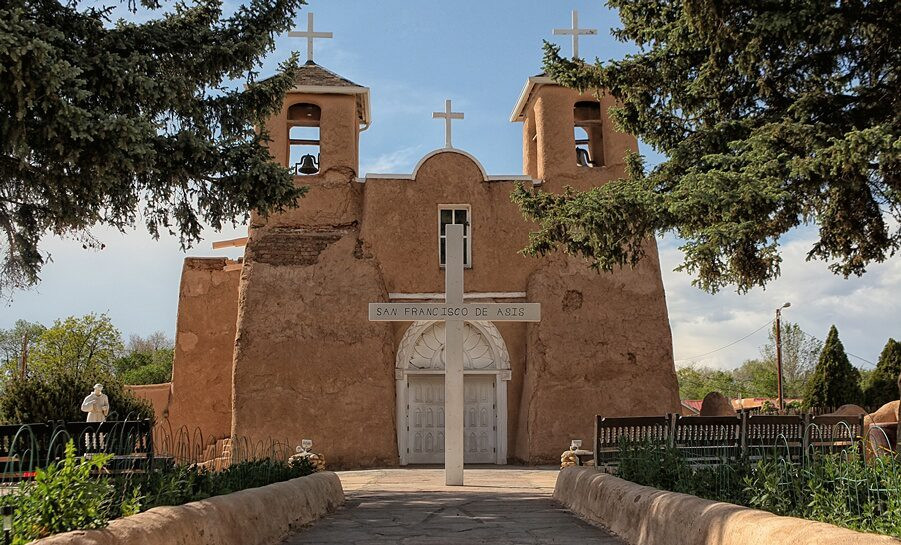 A view of the front of San Francisco de Asis church in Ranchos de Taos
A view of the front of San Francisco de Asis church in Ranchos de Taos
Tips for Finding LGBTQ+ Friendly Accommodations
- Read Reviews: Read online reviews from other LGBTQ+ travelers to get an idea of the experiences they had at different accommodations.
- Contact the Accommodation Directly: If you have any questions or concerns, contact the accommodation directly to ask about their policies and practices.
- Look for LGBTQ+ Certifications: Some accommodations have received certifications from LGBTQ+ organizations, indicating their commitment to inclusivity.
- Support LGBTQ+ Owned Businesses: Consider staying at LGBTQ+ owned accommodations to support the community and ensure a welcoming experience.
Gaymexico.net Resources
Check gaymexico.net for curated lists of LGBTQ+ friendly accommodations in Taos and Santa Fe, as well as travel tips and recommendations for the area.
10. What Events and Festivals Should I Attend Between Taos and Santa Fe?
The area between Taos and Santa Fe is known for its vibrant arts and culture scene, with numerous events and festivals taking place throughout the year. From traditional Native American ceremonies to world-class art markets, there’s something for everyone to enjoy. Here are some of the must-attend events and festivals in the region.
Traditional Native American Events
Native American culture is an integral part of the Taos and Santa Fe region, and there are several traditional events that offer a glimpse into this rich heritage.
- Taos Pueblo Powwow: Held every July, the Taos Pueblo Powwow is a celebration of Native American culture, with traditional dances, music, and food.
- Eight Northern Indian Pueblos Arts and Crafts Show: Held every July, this show features the work of artists from the eight northern Indian pueblos of New Mexico.
- Feast Days: Each of the Native American pueblos has its own feast day, which is a religious celebration that includes traditional dances and ceremonies.
Art Markets and Festivals
Taos and Santa Fe are known for their vibrant arts scene, and there are several art markets and festivals that showcase the work of local and international artists.
- Santa Fe Indian Market: Held every August, the Santa Fe Indian Market is the largest and most prestigious Native American art market in the world.
- Spanish Market: Held every July, the Spanish Market features the work of artists who create traditional Spanish colonial art forms.
- Taos Arts Festival: Held every September, the Taos Arts Festival features the work of artists from Taos and the surrounding area.
Music Festivals
The area between Taos and Santa Fe hosts several music festivals throughout the year, featuring a variety of genres from classical to country to rock.
- Santa Fe Opera: Held every summer, the Santa Fe Opera is one of the world’s leading opera companies.
- Taos Solar Music Festival: Held every summer, the Taos Solar Music Festival features a lineup of national and international musicians.
- Music from Angel Fire: Held every summer, Music from Angel Fire is a classical music festival that takes place in the beautiful setting of Angel Fire, New Mexico.
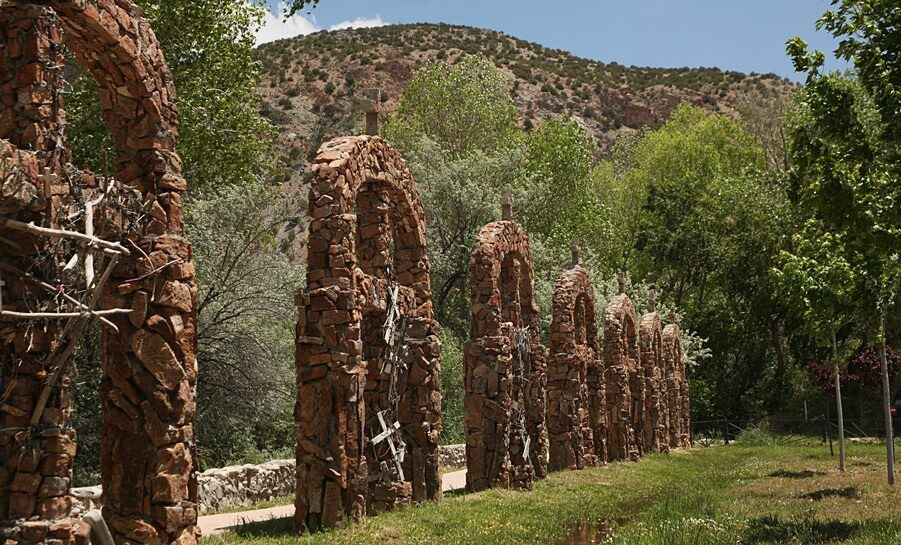 Stone arches at Santuario de Chimayo
Stone arches at Santuario de Chimayo
Other Events and Festivals
In addition to
